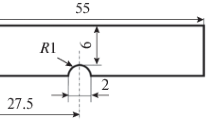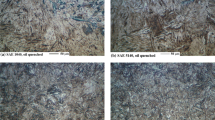Conclusions
-
1.
The work of crack propagation increases when the tempering temperature for quenched carbon structural steels is raised from 400 to 600°.
-
2.
With tempering of quenched carbon steels to the same hardness the impact toughness and work of crack propagation at room temperature vary little with a change of the carbon content from 0.3 to 0.5%.
Similar content being viewed by others
Literature cited
A. P. Gulyaev et al., "Mechanics of failure in impact bending tests," in: Metal Science and Heat Treatment, Yu. M. Lakhtin and G. N. Dubinin, eds. [in Russian], NTO MAShPROM, No. 5, Mashinostroenie, Moscow (1968), p. 64.
Ya. R. Rauzin and A. V. Velikanov, "Modern methods of determining impact toughness," Metal. i Term. Obrabotka Metal., 6, 28 (1970).
S. E. Kovchik et al., "Effect of heat treatment on resistance of some steels to crack nucleation and propagation," Fiz.-Khim. Mekhan. Mat.,8, 5, 33 (1972).
Additional information
Grozny Petroleum Institute. Translated from Metallovedenie i Termicheskaya Obrabotka Metallov, No. 1, pp. 66–67, January, 1975.
Rights and permissions
About this article
Cite this article
Makhukov, N.G. Impact toughness of carbon steels. Met Sci Heat Treat 17, 72–73 (1975). https://doi.org/10.1007/BF00663096
Issue Date:
DOI: https://doi.org/10.1007/BF00663096




